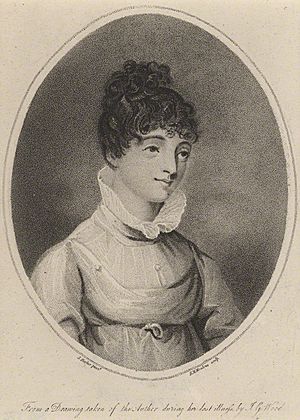Elizabeth Smith (translator) facts for kids
Elizabeth Smith (born December 1776 – died August 1806) was a very talented English scholar. She was known for translating texts, knowing many languages, and studying the Bible and ancient Eastern cultures.
Contents
Elizabeth Smith: A Life of Learning
Early Years and Education
Elizabeth Smith was born in December 1776 at Burn Hall, a family home near Durham, England. She was the second child and oldest daughter of George and Juliet Smith. Elizabeth was a very smart child who loved books. She never went to school but was mostly taught by her mother.
In 1782, her family moved to Suffolk. They returned to Burn Hall in 1785. Her father was involved in banking, and they later moved to Piercefield Park in Monmouthshire. By this time, Elizabeth was already good at music. For three years, she had a governess who taught her French and a little Italian. All the other languages she learned, she taught herself!
A Self-Taught Genius
The family had a great library, and Elizabeth loved to read, especially poetry. She would study for hours before breakfast every morning. She improved her Italian and by 1793, she could read Spanish easily.
In 1793, a financial crisis happened because France declared war. This caused many banks, including her father's, to fail. Her father left Piercefield and joined the army in 1794. Elizabeth spent several months in Bath, where her friend Mary Hunt encouraged her to study German and botany. By the end of that year, she started learning Arabic and Persian.
She began studying Latin in November 1794. By February 1795, she had already read many famous Latin books, like those by Caesar and Cicero, and was excited to start Virgil. After joining her father in Sligo, she found an Irish grammar book and immediately began to learn it.
Elizabeth started learning Hebrew around October 1796. By 1797, she was already translating from the Book of Genesis. In 1799, she found a Syriac New Testament and could read it very well. She always carried a book called Buxtorf's Florilegium with her.
In 1799, her family settled in Ballitore, Ireland. In 1801, they moved to Coniston, where Elizabeth lived for the rest of her life. In 1802, she met the writer Elizabeth Hamilton, who was very impressed by her.
Her Final Years
After a year of declining health, Elizabeth Smith passed away in Coniston on August 7, 1806. She was buried in Hawkshead, where a special tablet honors her memory in the local church.
Elizabeth's Amazing Skills and Works
Elizabeth Smith had an incredible memory and a special ability to understand things, almost like guessing, because she rarely needed to look up words in a dictionary. Translating from Hebrew was her "Sunday work." Besides her amazing intellectual talents, Elizabeth was also excellent at cooking, needlework, and horse riding. Among her language studies, she had lists of words in Welsh, Chinese, and African dialects, along with some Icelandic studies.
After she passed away, some of her writings were published:
- Fragments, in Prose and Verse… (1808): This book included parts of her writings and a story about her life by Henrietta Maria Bowdler. It also had her translations of parts of the Bible (Jonah chapter 2 and Habakkuk chapter 3).
- Memoirs of Frederick and Margaret Klopstock, translated from the German (1808): This was her translation of stories about the Klopstock family.
- The Book of Job, translated (1810): This was her translation of the Book of Job from the Bible. It was highly praised by important religious leaders.
- A Vocabulary, Hebrew, Arabic, and Persian (1814): This book was a dictionary of words in Hebrew, Arabic, and Persian. It was noted that she was the first person to compare these three languages in such a detailed way.
Some of her teaching writings also appeared in a book called The Lady's Monitor in 1828. Elizabeth Smith was also the first person to introduce the work of Meta Klopstock to English readers through her 1808 translation.


